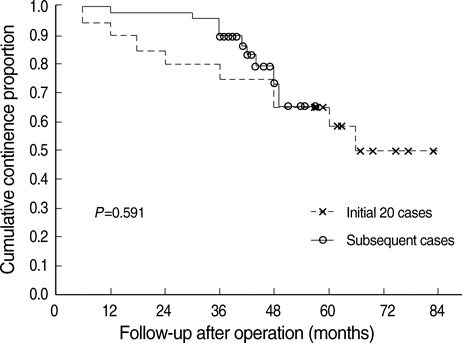J Korean Med Sci.
2009 Dec;24(6):1182-1186. 10.3346/jkms.2009.24.6.1182.
Long-Term Results of Laparoscopic Burch Colposuspension for Stress Urinary Incontinence in Women
- Affiliations
-
- 1Department of Urology, Dankook University College of Medicine, Cheonan, Korea.
- 2Department of Urology, Asan Medical Center, University of Ulsan College of Medicine, Seoul, Korea.
- 3Department of Urology, Samsung Medical Center, Sungkyunkwan University School of Medicine, Seoul, Korea. ksleedr@skku.edu
- KMID: 1783152
- DOI: http://doi.org/10.3346/jkms.2009.24.6.1182
Abstract
- We evaluated the long-term efficacy of laparoscopic Burch colposuspension for stress urinary incontinence (SUI) in women. A total of 68 patients who underwent extraperitoneal laparoscopic Burch colposuspensions with more than a 3-yr follow-up were included. The colposuspension was performed by using two non-absorbable sutures on each side. The patients were considered to be cured of SUI if they had a negative result of cough stress test and there were no reports of urine leakage during physical stress. The mean follow-up period was 52 months (range, 36 to 83 months). The overall subjective cure rate was reported in 49 patients (72%). There was no significant difference between the cured and non-cured group in terms of clinical parameters. The cure rate tended to decline gradually over time and it was more deteriorated significantly after 4 yr of surgery. Based on these results, we recommend that long-term follow-up is needed when evaluating the clinical efficacy of anti-incontinence surgery.
MeSH Terms
Figure
Reference
-
1. Abrams P, Cardozo L, Fall M, Griffiths D, Rosier P, Ulmsten U, van Kerrebroeck P, Victor A, Wein A. The standardisation of terminology of lower urinary tract function: report from the Standardisation Sub-committee of the International Continence Society. Neurourol Urodyn. 2002. 21:167–178.
Article2. McDougall EM. Laparoscopic management of female urinary incontinence. Urol Clin North Am. 2001. 28:145–149.
Article3. Burch JC. Urethrovaginal fixation to Cooper's ligament for correction of stress incontinence, cystocele, and prolapse. Am J Obstet Gynecol. 1961. 81:281–290.
Article4. Alcalay M, Monga A, Stanton SL. Burch colposuspension: a 10-20 year follow up. Br J Obstet Gynaecol. 1995. 102:740–745.
Article5. Drouin J, Tessier J, Bertrand PE, Schick E. Burch colposuspension: long-term results and review of published reports. Urology. 1999. 54:808–814.
Article6. Vancaillie TG, Schuessler W. Laparoscopic bladder neck suspension. J Laparoendosc Surg. 1991. 1:169–173.7. Buller JL, Cundiff GW. Laparoscopic surgeries for urinary incontinence. Clin Obstet Gynecol. 2000. 43:604–618.
Article8. Stothers L. Reliability, validity, and gender differences in the quality of life index of the SEAPI-QMM incontinence classification system. Neurourol Urodyn. 2004. 23:223–228.
Article9. Blaivas JG, Olsson CA. Stress incontinence: classification and surgical approach. J Urol. 1988. 139:727–731.
Article10. Tanagho EA. Colpocystourethropexy: the way we do it. J Urol. 1976. 116:751–753.
Article11. Lapitan MC, Cody DJ, Grant AM. Open retropubic colposuspension for urinary incontinence in women. Cochrane Database Syst Rev. 2003. CD002912.
Article12. Liu CY, Paek W. Laparoscopic retropubic colposuspension (Burch procedure). J Am Assoc Gynecol Laparosc. 1993. 1:31–35.
Article13. Dean NM, Ellis G, Wilson PD, Herbison GP. Laparoscopic colposuspension for urinary incontinence in women. Cochrane Database Syst Rev. 2006. 3:CD002239.
Article14. Persson J, Wolner-Hanssen P. Laparoscopic Burch colposuspension for stress urinary incontinence: a randomized comparison of one or two sutures on each side of the urethra. Obstet Gynecol. 2000. 95:151–155.
Article15. el-Toukhy TA, Davies AE. The efficacy of laparoscopic mesh colposuspension: results of a prospective controlled study. BJU Int. 2001. 88:361–366.
Article16. Zullo F, Palomba S, Russo T, Sbano FM, Falbo A, Morelli M, Pellicano M, Mastrantonio P. Laparoscopic colposuspension using sutures or prolene meshes: a 3-year follow-up. Eur J Obstet Gynecol Reprod Biol. 2004. 117:201–203.
Article17. Ross J. Two techniques of laparoscopic Burch repair for stress incontinence: a prospective, randomized study. J Am Assoc Gynecol Laparosc. 1996. 3:351–357.
Article18. Carey MP, Goh JT, Rosamilia A, Cornish A, Gordon I, Hawthorne G, Maher CF, Dwyer PL, Moran P, Gilmour DT. Laparoscopic versus open Burch colposuspension: a randomised controlled trial. BJOG. 2006. 113:999–1006.
Article19. Kitchener HC, Dunn G, Lawton V, Reid F, Nelson L, Smith AR. Laparoscopic versus open colposuspension--results of a prospective randomised controlled trial. BJOG. 2006. 113:1007–1013.
Article20. Sirls LT, Keoleian CM, Korman HJ, Kirkemo AK. The effect of study methodology on reported success rates of the modified Pereyra bladder neck suspension. J Urol. 1995. 154:1732–1735.
Article21. Jenkins TR, Liu CY. Laparoscopic Burch colposuspension. Curr Opin Obstet Gynecol. 2007. 19:314–318.
Article22. De Cuyper EM, Ismail R, Maher CF. Laparoscopic Burch colposuspension after failed sub-urethral tape procedures: a retrospective audit. Int Urogynecol J Pelvic Floor Dysfunct. 2008. 19:681–685.
Article
- Full Text Links
- Actions
-
Cited
- CITED
-
- Close
- Share
- Similar articles
-
- Comparison of Extraperitoneal Laparoscopic Versus Open Burch Colposuspension for Treatment of Stress Urinary Incontinence: Long Term Follow-up
- An unusual foreign body in the bladder 5 years after a laparoscopic burch colposuspension
- Comparative Evaluation of Abdominal, Transvaginal and Laparoscopic Burch Colposuspension for Genuine Stress Incontinence
- Laparoscopic Burch Colposuspension (Transperitoneal Approach)
- Comparison of Extraperitoneal Laparoscopic Burch versus Open Burch and Raz`s Suspension for Female Genuine Stress Urinary Incontinence


